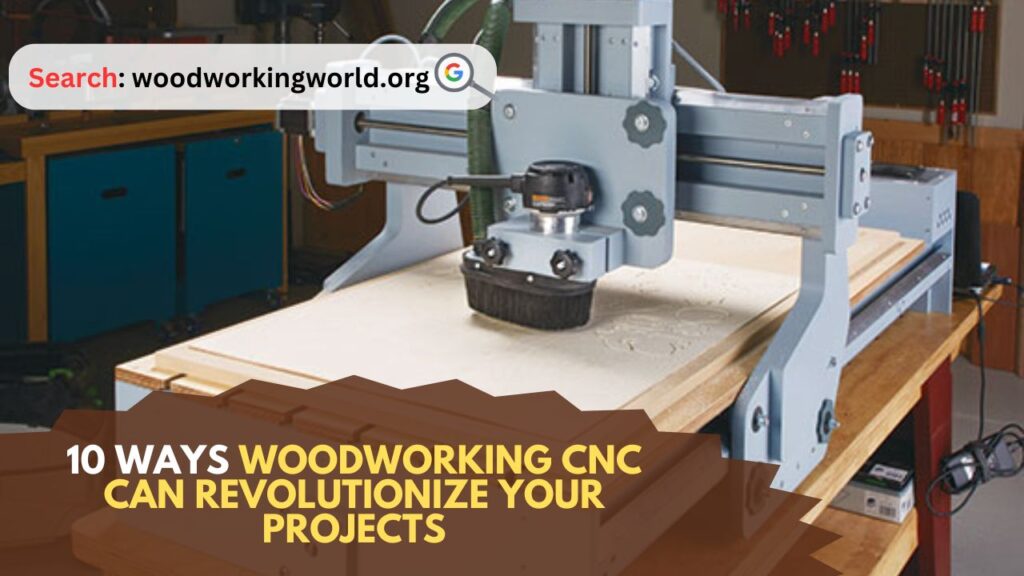Woodworking CNC: Woodworking has seen major changes over the years, with technology playing a key role in how the industry has evolved. One of the most impactful advancements in woodworking is the introduction of Computer Numerical Control (CNC) machines. These machines have completely transformed the way woodworkers approach their projects, offering precision, efficiency, and versatility. In this article, we’ll explore 10 ways woodworking CNC can revolutionize your projects, helping you take your craftsmanship to the next level.

10 Ways Woodworking CNC Can Revolutionize Your Projects
1. Precision and Accuracy
Traditional woodworking methods often depend on the skill and expertise of the craftsman, which can lead to variations in the final product. CNC machines, however, operate with unmatched precision and accuracy. By programming detailed designs and executing them flawlessly, CNC ensures that every cut, carve, and joint is precisely replicated, resulting in a finished product that meets the highest standards of craftsmanship.
2. Replicating Complex Designs
Woodworkers often find it challenging to replicate intricate designs or patterns manually. CNC machines excel at reproducing complex designs with ease. Whether it’s intricate carvings, detailed engravings, or elaborate inlays, CNC technology allows woodworkers to recreate designs with unprecedented detail, opening up new creative possibilities.
3. Efficient Material Use
CNC machines use advanced nesting algorithms to optimize material usage. These algorithms calculate the most efficient arrangement of cuts on a given material sheet, minimizing waste and maximizing yield. This not only saves you money but also helps promote sustainability by reducing waste.
4. Time Efficiency
The efficiency of CNC machines in executing repetitive tasks is unmatched. What might take hours or even days to complete manually can be accomplished in a fraction of the time with a CNC machine. This time-saving aspect boosts productivity and allows you to take on more projects and meet tight deadlines without sacrificing quality.
5. Intricate Joinery and Complex Cuts
Creating intricate joinery or executing complex cuts manually can be challenging and time-consuming. CNC machines, equipped with precise cutting tools, excel at creating complex joinery and intricate cuts with ease. Whether it’s dovetails, mortise and tenon joints, or custom-designed cuts, CNC technology lets you achieve precision and intricacy that would be hard to attain with traditional methods.
6. Scalability and Consistency
For woodworkers involved in mass production or creating multiples of the same item, maintaining consistency is key. CNC machines ensure that each piece is an exact replica of the original design, eliminating variations that might arise from manual processes. This scalability and consistency make CNC technology perfect for producing large quantities of high-quality woodworking projects.
7. Customization and Personalization
CNC machines provide endless opportunities for customization and personalization. You can easily program the machine to engrave names, logos, or unique designs onto your projects. This capability opens up new possibilities for creating bespoke pieces that cater to the individual preferences of clients, making each project truly unique.
8. Innovative 3D Carving
Traditional woodworking methods may struggle to achieve intricate 3D carvings or contours. CNC machines, equipped with specialized carving tools, excel at creating three-dimensional masterpieces. Whether it’s sculpted furniture, artistic reliefs, or intricate sculptures, the ability to add depth and dimension to woodworking projects expands your creative possibilities.
9. Reduced Skill Barrier
Traditional woodworking requires a high level of skill and expertise, but CNC machines lower the skill barrier for entry into the field. With user-friendly software interfaces and automated processes, individuals with varying levels of woodworking experience can quickly learn to operate CNC machines. This opens up the field to more people and lets them explore their creative potential.
10. Working with Advanced Materials
Woodworking CNC machines aren’t limited to traditional wood materials. They can also work with a variety of advanced materials, including composites, plastics, and metals. This versatility lets you experiment with innovative designs and materials, expanding the scope of your projects beyond the constraints of conventional woodworking.
Conclusion: Woodworking CNC
Woodworking CNC machines have undeniably revolutionized the industry, providing woodworkers with powerful tools to enhance their creativity, precision, and efficiency. From intricate designs to efficient material utilization and lowered skill barriers, CNC technology’s impact on woodworking projects is far-reaching. As technology advances, the integration of CNC machines into woodworking practices will likely become even more widespread, shaping the future of craftsmanship in this timeless and evolving art form.
I hope this article on Woodworking CNC has been helpful. If you have any further questions, please feel free to leave a comment below.
Video
